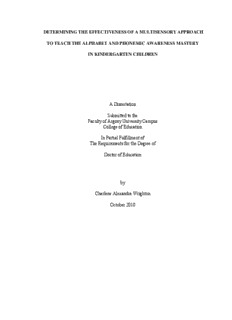
Determining the Effectiveness of a Multisensory Approach To Teach the Alphabet and Phonemic ... PDF
Preview Determining the Effectiveness of a Multisensory Approach To Teach the Alphabet and Phonemic ...
i DETERMINING THE EFFECTIVENESS OF A MULTISENSORY APPROACH TO TEACH THE ALPHABET AND PHONEMIC AWARENESS MASTERY IN KINDERGARTEN CHILDREN A Dissertation Submitted to the Faculty of Argosy University Campus College of Education In Partial Fulfillment of The Requirements for the Degree of Doctor of Education by Charlene Alexandra Wrighton October 2010 ii DETERMINING THE EFFECTIVENESS OF A MULTISENSORY APPROACH TO TEACH THE ALPHABET AND PHONEMIC AWARENESS MASTERY IN KINDERGARTEN CHILDREN Copyright ©2010 Charlene Alexandra Wrighton All rights reserved iii DETERMINING THE EFFECTIVENESS OF A MULTISENSORY APPROACH TO TEACH THE ALPHABET AND PHONEMIC AWARENESS MASTERY IN KINDERGARTEN CHILDREN A Dissertation Submitted to the Faculty of Argosy University Campus in Partial Fulfillment of the Requirements for the Degree of Doctor of Education by Charlene Alexandra Wrighton Argosy University October 2010 Dissertation Committee Approval: ___________________________________ __________________________________ Dissertation Chair: Dr. Scott Griffith Date ___________________________________ Committee Member: Dr. Aniello Malvetti ___________________________________ __________________________________ Committee Member: Dr. Barbara Cole Program Chair: Ardella Dailey iv DETERMINING THE EFFECTIVENESS OF A MULTISENSORY APPROACH TO TEACH THE ALPHABET AND PHONEMIC AWARENESS MASTERY IN KINDERGARTEN CHILDREN Abstract of Dissertation Submitted to the Faculty of Argosy University Campus College of Education in Partial Fulfillment of the Requirements for the Degree of Doctor of Education by Charlene Alexandra Wrighton Argosy University October 2010 _______________________________________________________ Dissertation Chair: Dr. Scott Griffith _______________________________________________________ Committee Member: Dr. Aniello Malvetti _______________________________________________________ Committee Member: Dr. Barbara Cole Department: College of Education v Abstract DETERMINING THE EFFECTIVENESS OF A MULTISENSORY APPROACH TO TEACH THE ALPHABET AND PHONEMIC AWARENESS MASTERY IN KINDERGARTEN CHILDREN Limited growth has been seen last 5 decades in the reading ability of the youth in the United States, regardless of legislation, funding, federal mandates, and agencies established to improve reading instruction. Over the last 3 decades research studies have informed education what children need to learn to read, spell, and write. How to deliver the instruction is still not resolved. The purpose of this study was to determine the effectiveness of a multisensory approach to teaching the alphabet and phonemic awareness to kindergarten children, in comparison to a more abstract and traditional language arts methodology. The SRA/Open Court Reading Series and the Zoo-Phonics Language Arts Program were the vehicles for this study. A quantitative, quasi-experimental research design was used in this study to assess Kindergarten students in 1 school district, in 6 kindergarten classes within 3 schools, having the same economic and ethnic demographics to find the effect. vi TABLE OF CONTENTS TABLE OF TABLES …………………………,……..……………..……………… xii TABLE OF FIGURES ………………………………………………..……………. xiii TABLE OF APPENDICES ………………………..…………………..…………. xiv ACKNOWLEDGMENTS……………………..………..………………………... xv CHAPTER 1: THE RESEARCH PROBLEM ………………….………….…….. 1 Statement of the Problem………………………………………………….. 1 Background……………………………………………….……………… 3 The Purpose of the Study…………………………………….…………….. 9 Theoretical Foundations……………………………………………………. 9 Hypotheses…………………………………………………………………. 13 Research Questions………………………………………………………… 14 Definition of Terms………………………………………………………... 14 Limitations…………………………………………………………………. 15 Delimitations……………………………………………………………….. 16 Significance of Study……………………………………………………….. 16 CHAPTER 2: LITERATURE REVIEW….……………………………………….. 19 The Purpose of the Study…………………………………………………... 19 Overview…………………………………………………………………… 19 Section 1: Theoretical Foundations………………………………………… 19 Theoretical Background…………………………………………... 20 Three Foundational Theories………………………………...…… 22 vii Section 2: Review of the Literature………………………………………… 25 The Achievement Gaps in Education……………………………... 25 Achievement Gaps Between Genders…………………………….. 26 A Note of Optimism………………………………………………. 28 The Reading Wars: The Background……………………………... 29 Federal Legislation Funds Programs Designed to Improve Literacy…………………………………….…..………………… 32 Best Practices in Reading…………………………………………. 34 Obstacles to Reading and Strategies to Overcome Them……..…. 38 The Alphabet: Symbolic and Abstract……………………………. 38 Pictorial Mnemonics to Help Cement Sound to Symbol…..…….. 41 Movement and Learning………..………………………………... 41 Play, Memory, and Learning……………………………………… 44 The Structure and Function of the Brain………………………….. 45 Stages and Types of Memory…………………………………….. 48 Classroom Application……………………………………………. 50 Gender Issues……………………...……………………………… 53 Differentiated Instruction…………………………………………. 56 Science and Educational Practice…………………………………. 57 Reading Programs Used in the Study……………………………... 59 Similarities and differences of the two reading programs 59 The SRA / Open Court Reading Program……………….. 60 Alphabet and Phonemic Awareness Instruction…………..……... 61 viii Zoo-Phonics Language Arts Program……………………………………… 65 History…………………………………………………………….. 65 The Essences of the Program……………………………………... 66 The Zoo-Phonics Kindergarten Program……………………….. 72 Summ ary…………………………………………………………………… 74 CHAPTER 3: METHODOLOGY…....………………………….…………………. 76 Restatement of the Problem………………………………………………... 76 Research Method and Design……………………………………………… 76 The Selection of Subjects…………………………………………………... 77 The Teachers in the Study………………………………………… 79 Demographics of Schools in the Study…………………………… 80 The Reading Programs Used in the Study……………………… 81 Instrum entation…………………………………………………………….. 84 The Test Instrument………………………………………………. 84 District Cluster Test Aligns With State Content Standards…..….. 84 District Cluster Test Time Frames………………………………... 85 Reliability and Validity…………………………………………… 86 District Cluster Test Content……………………………………… 86 District Cluster Test Time Frames………………………………... 88 Data Collection Procedures………………………………………………… 88 Institutional Review Board…………………………………………………. 91 Data Analysis………………………………………………………………. 92 SPSS Tests………………………………..……………………… 92 ix Research Questions……………………………………………….. 92 CHAPTER 4: FINDINGS ……………..………………………………………….… 95 Introduction of Content…………………………………………………….. 95 Overview…………………………………………………………………… 95 Data Presentation…………………………………………………………… 96 Research Question 1………………………………………………. 96 Research Question 2………………………………………………. 106 Research Question 3………………………………………………. 109 Consonants………………………………………………………... 111 Vowels…………………………………………………………….. 111 Summary of Findings………………………………………………………. 113 Conclusions and Summary of Findings for Research Question 1… 113 Conclusions and Summary of Findings for Research Question 2… 115 Conclusions and Summary of Findings for Research Question 3... 117 CHAPTER 5: SUMMARY, CONCLUSIONS, AND RECOMMENDATIONS….. 121 Overview…………………………………………………………………… 121 Hypotheses………………………………………………………... 121 The Research Questions…………………………………………... 122 Data Presentation…………………………………………………………… 122 District Cluster Tests 122 Interpretation of Data 123 Summary Conclusions for Research Question 1 123 Results 124 x DCT 1 Uppercase Letter Recognition by Letter Name 124 Analysis 125 DCT 2 Lowercase Letter Recognition by Letter Name 126 Analysis 126 DCT 3 Blending Compound Words and Onset and Rimes 127 Analysis 128 DCT 4 Rhyming 129 Analysis 130 DCT 5 Blending Phonemes 130 Analysis 131 DCT 6 Segmenting Phonemes 131 Analysis 132 Summary of DCTs in Research Question 1 132 Overall Analysis 133 Hypothesis 134 Research Question 2 134 District Cluster Test 7 and Test Results 134 Summary for Research Question 2 135 Hypothesis 136 Research Question 3 136 Summary for Research Question 3 138 Analysis 138 Hypothesis 139
Description: